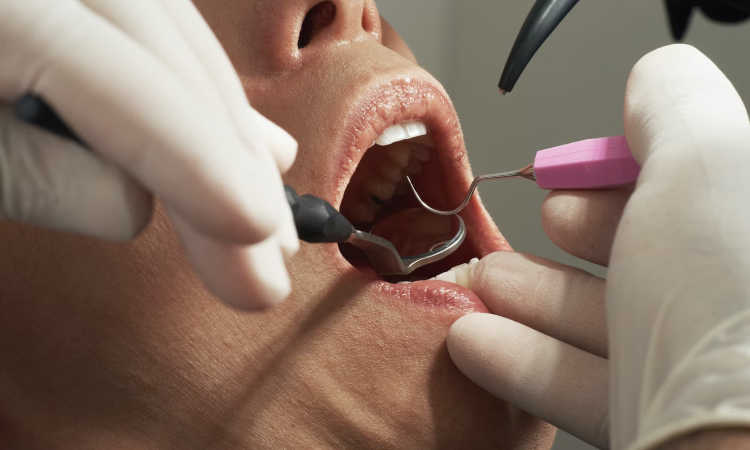How Do Dental Implants Work With Dentures? A Complete Overview

How Do Dental Implants Work With Dentures? A Complete Overview
If you wear removable dentures, you’re likely all too familiar with the many hassles – slippage while eating or talking, discomfort from rubbing, and difficulty eating foods you love.
But what if there was a more permanent solution to restore your smile and oral function?
That’s where dental implants come in.
Getting dental implants is an increasingly popular choice to securely anchor partial or full dentures in place long-term. But exactly how does the implant process work with dentures? Let’s dig into all the nitty gritty details so you can determine if implants are the right solution for your needs.
Dental Implant Basics – A Quick 101
First, a quick overview of what dental implants are and how they work.
Dental implants are tiny titanium metal posts that are surgically inserted into the jawbone as artificial roots to permanently replace missing teeth. The implant post is capped with an abutment that acts as the new root top. Replacement teeth, whether a single crown, bridge, or full denture, are then securely fastened onto the abutments.
Over the 3-6 months after surgery, a process called osseointegration occurs. This is where the jawbone fuses tightly to the implant surface, anchoring it firmly in place. This creates a remarkably sturdy foundation for attaching replacement teeth.
The huge advantage implants have over traditional removable dentures is the way they permanently integrate with the jawbone itself. This provides far superior stability and retention compared to dentures that just sit loosely atop gum tissue. With implants, no more slipping, rubbing, or rocking in the mouth!
How Dental Implants Are Used for Partial and Full Dentures
Dental implants can provide retention and support for both partial dentures replacing just several missing teeth and full dentures replacing all upper or lower teeth.
For partial denture implants support, typically 2-4 individual dental implants are ideal. The partial denture literally snaps onto fixtures called abutments that are screwed into the implants. This creates firm, lasting retention.
For more significant tooth loss requiring a full upper or lower denture, a minimum of 4 implants is generally recommended – some placed toward the front of the jaw, the others toward the back. The full denture then attaches securely onto the implants using a ball-and-socket style retention system. This specialized attachment method is called a locator attachment or locator abutment.
With several implants spread strategically to anchor it, full denture implants gain tremendously enhanced stability and function compared to traditional loose-fitting dentures. An implant-supported full denture also helps prevent continued jawbone loss, which occurs when dentures simply press on gum tissue rather than integrating with the bone itself.
Step-by-Step – What to Expect During the Dental Implant Procedure
Here is a step-by-step overview of what you can expect during the actual dental implant surgery itself:
- Local anesthesia will be administered to fully numb the treatment area before procedures begin. This ensures you remain comfortable throughout the process.
- Your dentist will begin by using surgical guides or stencils mapped to your precise anatomy to mark the exact sites where each implant post should be positioned within the jawbone for optimal denture support.
- At each marked site, your dentist will use precision drills to create tiny holes within the jawbone where the implants will be inserted. Depth and direction are precisely calculated.
- Next, the titanium implant posts are taken out of sterile packaging and placed into the openings created in the bone. Using a torque wrench, the dentist slowly turns and tightens the implants into position until they are seated completely flush with the surface of the jawbone.
- Once all implants are positioned correctly, your gums will be sutured closed overtop of them to protect the sites while osseointegration takes hold over the next several months.
- Temporary dentures are often provided to wear during the initial healing phase until permanent dentures can be fabricated and attached to the integrated implants.
Though it certainly sounds involved, the entire implant surgery is minimally invasive and typically completed in well under an hour. Most patients report only mild swelling and minimal discomfort for the first few days following placement as the sites heal.

The Full Dental Implant Timeline From Start to New Smile
Getting implant-supported dentures is a process involving multiple phases of treatment over 6-9 total months:
- Consultation appointment: Initial exam, scanning, and assessment to determine your candidacy for implants.
- Surgery visit: Implants are placed into precisely mapped sites within the jawbone during a 30-60 minute minimally invasive procedure.
- Healing phase: The critical integration period where the bone fuses to the implant surface over 3-6 months.
- Abutment placement: Once fully integrated, abutments are attached to the tops of the implants.
- Restoration: Final dentures designed specifically to attach to the abutments are fabricated and seated.
Throughout the process, temporary transitional dentures may be provided to comfortably wear as you heal until the permanent dentures can be created and attached to integrated implants.
Who Makes an Ideal Candidate for Implant-Supported Dentures?
While many patients can benefit from the stability implants offer, the ideal candidates for implant dentures are those who have adequate density and volume of jawbone to successfully secure and integrate multiple implants.
To determine candidacy, your dentist will assess the current quality and anatomy of your jawbone through dental exams, x-rays, CT-scans, and in some cases, bone grafts. Healthy bone density provides the sturdy foundation implants required for longevity.
Those who smoke cigarettes or use tobacco face much higher risks of implant failure and complications. Quitting smoking for at least several months before treatment is typically recommended.
Certain health conditions like diabetes or autoimmune disorders that inhibit healing can also negatively impact success rates. Be sure to discuss your complete medical history with your dentist.
If bone loss is moderate, grafting procedures may be done first to help regenerate density where implants will be placed. This helps maximize the chances of healthy fusion.
The Many Benefits Implant-Supported Dentures Offer
Opting for dental implants to provide lasting retention and support for partial or full dentures offers many great benefits for patients:
- Remarkably enhanced comfort – None of the rubbing, slipping, or rocking of traditional loose dentures.
- Superior fit and function – Implants allow dentures to fit snugly against the gums like natural teeth. Biting force is also far stronger.
- Dramatically improved aesthetics – An integrated custom smile that looks and feels incredibly life-like.
- Preserves facial bone – Unlike regular dentures which accelerate bone loss, implants help maintain facial structure over time.
- Eat anything! – Firmly anchored dentures allow comfortably eating harder, previously avoided foods.
- Permanent solution – Unlike removable dentures, implants don’t require adhesives or nightly removal. They are designed to last decades with proper care.
- Restored confidence – Many patients report implants eliminating denture-related embarrassment and improving self-esteem.
While implants do have a higher upfront investment than conventional dentures, for many the benefits make them well worth the cost and time commitment. They provide restored function and confidence that lasts years.
Choosing an Experienced Specialist You Can Trust
If you’re considering utilizing dental implants to stabilize your partial or full dentures, it’s critical to choose an implant dentist with specialized skills, training, and a proven track record of success. Never go with the lowest cost option – this is one case where expertise is well worth the investment.
If slipping dentures are impacting your quality of life, reclaim comfort and confidence through implant supported dentures. Schedule an implant consultation to discuss your options today!
Contact for more information at RamlaouiDDS
Contact us today to schedule a consultation.
Read our blog and start your journey toward a healthier and more attractive smile.
No insurance-ask for a fee for service saving
Call 408-275-6430
Text 669-259-8604
Summing Up
- Dental implants offer a permanent solution for securely anchoring partial and full dentures. After implants fuse to the jawbone, custom dentures snap onto abutments connected to the implants for superior stability and function.
- The process spans about 6-9 months in total, including consultations, minimally invasive implant surgery, a 3-6 month integration period, abutment placement, and finally restoration with the implant-supported denture.
- Ideal candidates have sufficient bone density and volume to successfully integrate multiple implants. When chosen for appropriate candidates, implants provide restored comfort, confidence, and ability to eat without denture slippage or rocking.
Patients Also Ask
How many implants do I need?
At least 2 for partials, 4-6 for full dentures. Your dentist will determine the ideal number and position.
How long is recovery after surgery?
Typically mild swelling and minimal discomfort for a few days that can be managed with OTC pain relievers.
How long until I get my permanent dentures?
Around 6-9 months to allow for complete implant integration before attaching final dentures.
Will it be obvious I have dentures? With a highly skilled dentist, implant supported dentures look completely natural.
Do I have to remove dentures to clean implants?
No, you care for them similarly to natural teeth with brushing and flossing.

